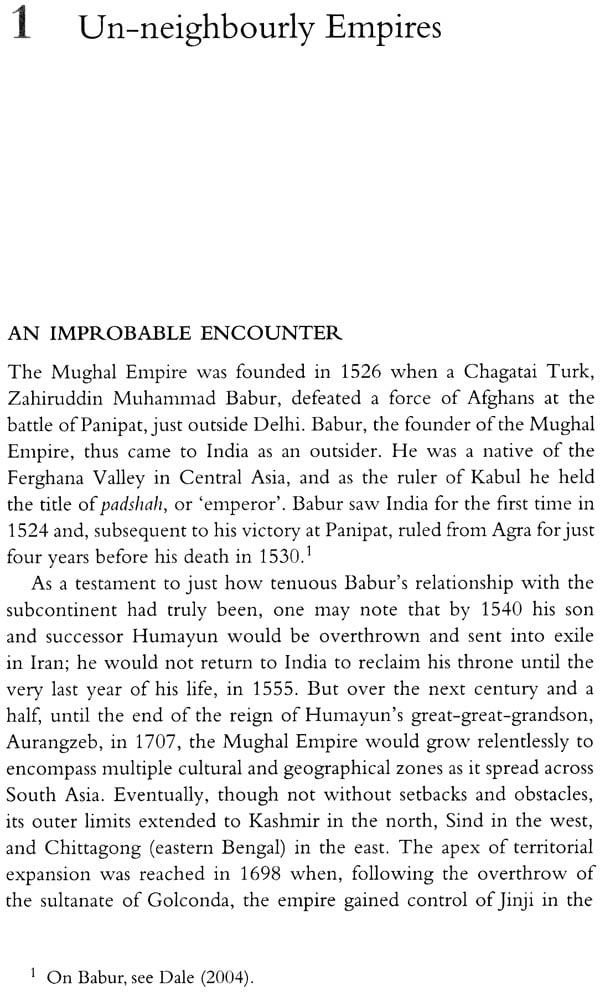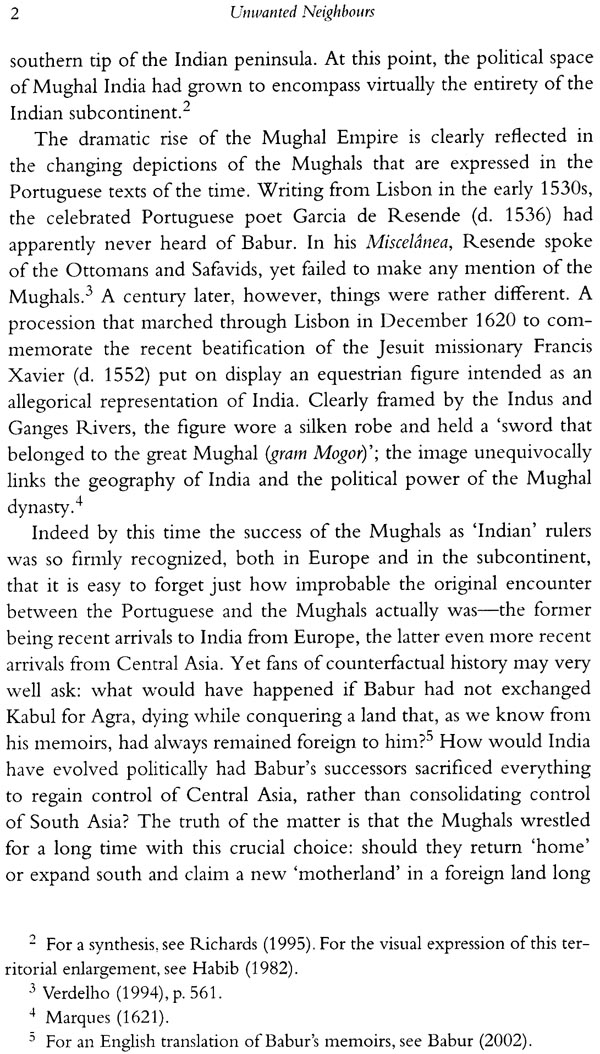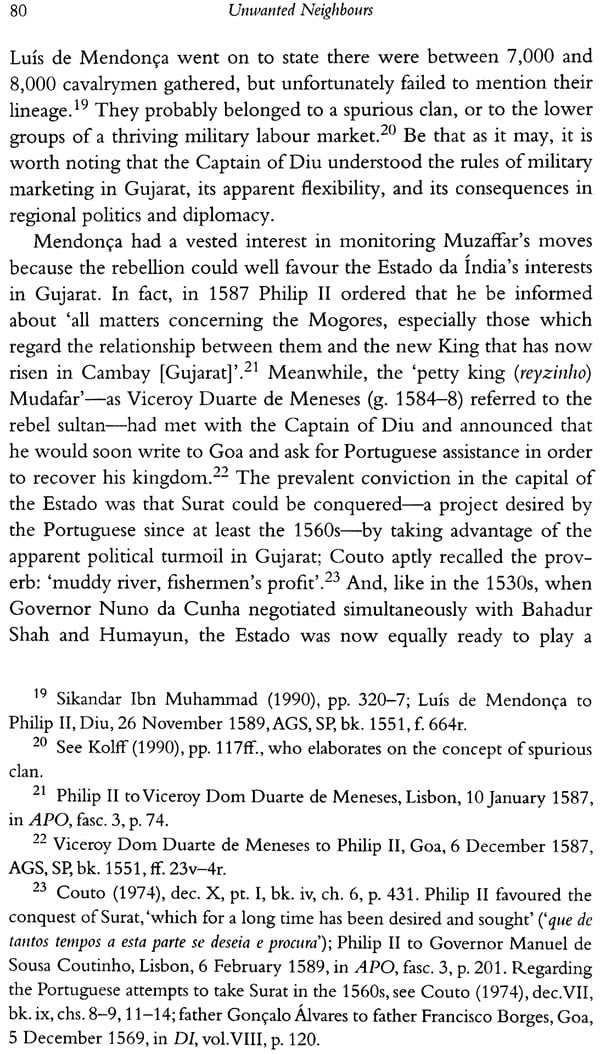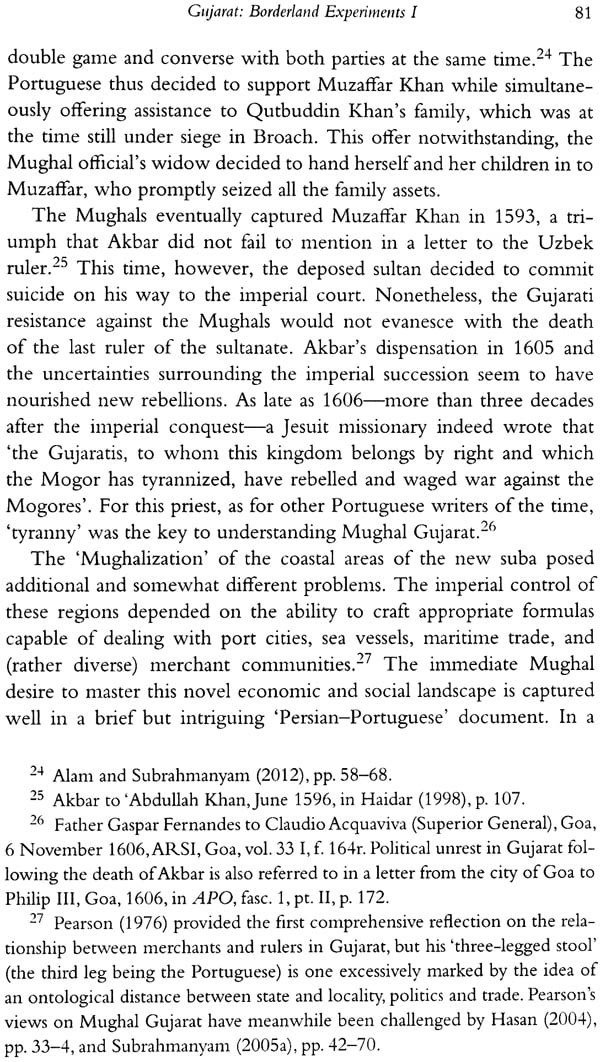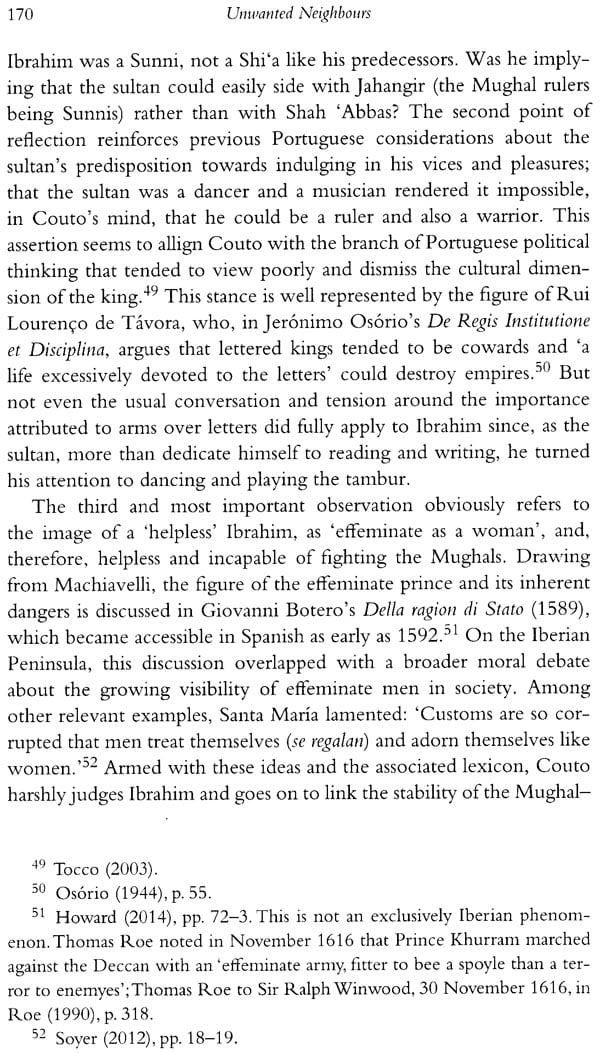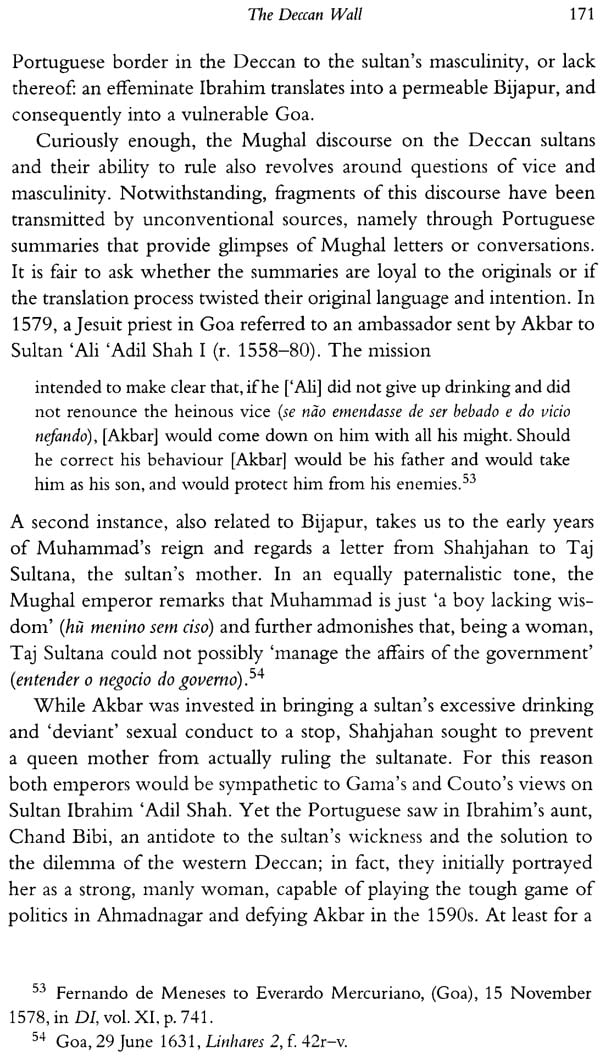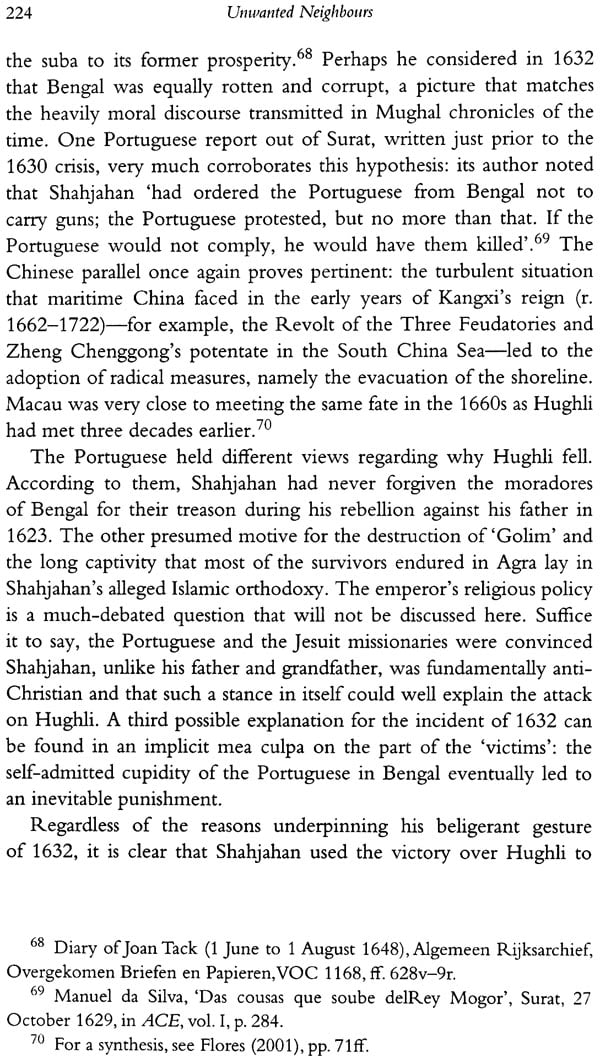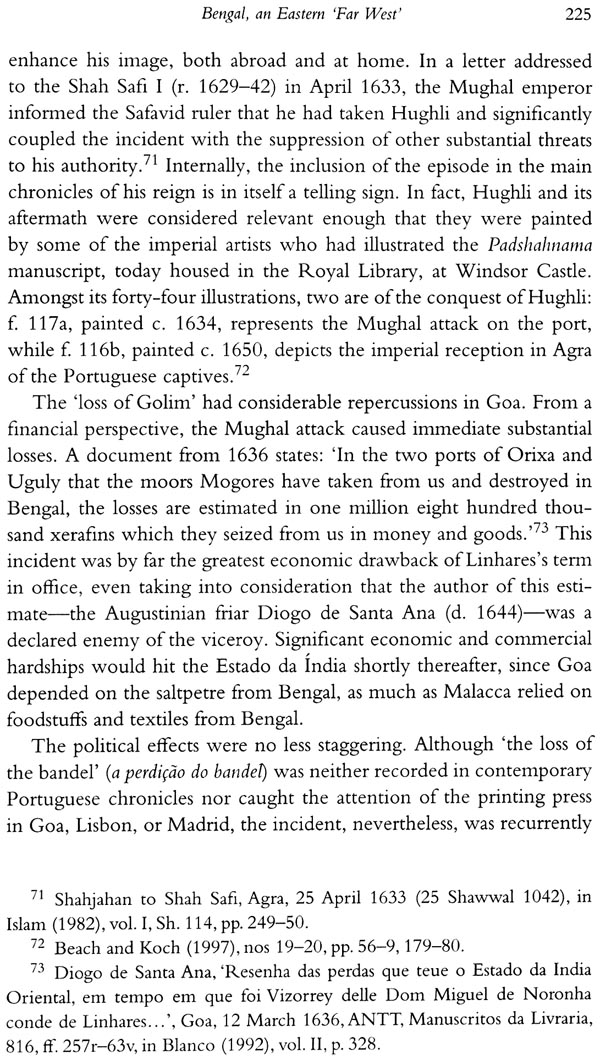
Unwanted Neighbours (The Mughals, The Portuguese, and Their Frontier Zones)
Book Specification
| Item Code: | NAR987 |
| Author: | Jorge Flores |
| Publisher: | Oxford University Press |
| Language: | English |
| Edition: | 2018 |
| ISBN: | 9780199486748 |
| Pages: | 326 |
| Cover: | HARDCOVER |
| Other Details | 8.50 X 5.50 inch |
| Weight | 480 gm |
Book Description
On 23 December 1572 the Mughal emperor Akbar arrived in the port city of Khambayat and, as the chronicler Muhammad ‘Arif Qandhari described it, ‘adorned the sea of Aman (Arabian Sea so called) by the light of his presence’. Having been raised in distant Kabul, Akbar had never in his thirty years been to the ocean. Another novelty was soon to follow: presumably anxious with the news about the Mughal military campaign in Gujarat and probably impressed by the imperial camp, several Portuguese merchants in Khambayat at the time rushed to Akbar’s presence. It was not the first time that a Mughal ruler had encountered anonymous Portuguese subjects; it had happened with Akbar’s father, also in Gujarat, roughly four decades earlier. Nonetheless, this poorly documented encounter of December 1572 launched a long, complex, and unequal relationship between a continental Muslim empire that was expanding into south India while often ‘looking back’ to Central Asia, and a European Christian empire that had been ‘written on water’ and whose rulers did not hesitate to consider themselves ‘kings of the sea’.
By the middle of the seventeenth century, these two empires faced each other across thoudsands of kilometres from Sind to Bijapur, with a supplementary eastern arm in faraway Bengal. Focusing on borderland management, imperial projects, and cross-cultural circulation, this volume delves into the ways in which, between c. 1570 and c. 1640, the Portuguese understood and dealt with their undesirably close neighbours-the Mughals.
Jorge Flores is professor of early modern global history at the European Universtiy Institute, Florence, italy.
On 23 December 1572 the Mughal emperor Akbar arrived in the port city of Khambayat and, as the chronicler Muhammad ‘Arif Qandhari described it, ‘adorned the sea of Aman (Arabian Sea so called) by the light of his presence’. Having been raised in distant Kabul, Akbar had never in his thirty years been to the ocean. Another novelty was soon to follow: presumably anxious with the news about the Mughal military campaign in Gujarat and probably impressed by the imperial camp, several Portuguese merchants in Khambayat at the time rushed to Akbar’s presence. It was not the first time that a Mughal ruler had encountered anonymous Portuguese subjects; it had happened with Akbar’s father, also in Gujarat, roughly four decades earlier. Nonetheless, this poorly documented encounter of December 1572 launched a long, complex, and unequal relationship between a continental Muslim empire that was expanding into south India while often ‘looking back’ to Central Asia, and a European Christian empire that had been ‘written on water’ and whose rulers did not hesitate to consider themselves ‘kings of the sea’.
The Mughal imperial system, then in the making, was just commencing its apprenticeship in the maritime world; this would have been indeed an utterly inconceivable horizon just a few decades earlier. Conversely, the Portuguese Estado da India, since its inception in 1505, was very much at ease with small polities and ‘liquid states’ in maritime Asia, from the Swahili coast to (politically fragmented) Japan. For the successive viceroys in charge of crafting political solutions in the capital city of Goa to directly face the colossal, land-based Asian powers constituted the exception until the 1570s. The Safavids, for example, all but ignored the Persian Gulf before the early seventeenth century. True, the Ottomans were considered in Goa to be a menace to the Arabian Sea, but were hardly viewed as a continuous territorial one to the Estado. The comparable case to Mughal India for the Portuguese at the time was probably Ming—Qing China, which had posed enormous challenges to Macau since the early days of this port city in the mid-sixteenth century. What was at stake in Goa with regard to the Mughals was far more vital and pressing still: from its threatened capital city, the Estado da India had to deal with the territorial encroachment by, and consequently a potential multi-front war with, a powerful northern ‘intruder’. In fact, by the middle of the seventeenth century the Mughal embrace to the Portuguese spanned thousands of kilometres from Sind to Bijapur, with a supplementary eastern ‘arm’ in faraway Bengal. A number of evolving geopolitical situations from Thatta to Chittagong required varied approaches from Goa and Lisbon. Indeed the arduous management of diverse frontier environments of Mughal India by a European power on the ground lies at the heart of this book. Unwanted Neighbours addresses the long relationship between the Portuguese and the undesirably close Mughals by placing frontier zones and borderlands front and centre.
The Portuguese challenges vis-a-vis the Mughals diverged from those faced by other Western players that entered the scene some decades later. The officials of the Estado da India had a state to safeguard; albeit a loose and ‘intermittent’ polity, it was one that exerted authority over a few pockets of land and several port cities surrounded by Asian neighbours. Conversely, the English and the Dutch in the area were servants of commercial companies; from a growing web of trading posts and factories, the agents of both the East Indian Company (EIC) and the Vereenigde Oost-Indische Compagnie (VOC) primarily looked after the business of their corporations in the Indian subcontinent and beyond (even if we are aware that these were hybrid enterprises, able to combine economic and political agendas). Despite their clear anxiety over crucial events that surfaced in Mughal India—successions, uprisings, wars, famines—and the negative effect such events had on trade, it is rather unlikely that the institutions these men represented considered the Mughals to be their neighbours in the same way as the Portuguese did. Another divergent point that distinguished the Portuguese interactions with Mughal India from those of the other Europeans was the strong religious component that characterized them, as exemplified in the three successive Jesuit missions to the imperial court (1580-3, 1590-1, and 1595 onwards). While this work does not address the Catholic missions at the imperial court per se, the Mughal—Portuguese frontier(s) cannot be understood without also taking into consideration the intricate relations the missionaries maintained with Mughal emperors, Portuguese viceroys, and myriad officials from both parties.
Unwanted Neighbours delves into the ways in which the Portuguese understood and dealt with their frontier zones with Mughal India between c. 1570 and c. 1640. It specifically looks at the western coast- line from Sind to the Konkan, particularly Gujarat; littoral Bengal from Pipli to Chittagong, with emphasis on the southwestern delta; and the southern continental frontier, that is, the western Deccan, or the sultanates of Ahmadnagar and Bijapur.° While the Estado da India was compelled to cope with Mughal conceptions of their political space and its limits, it is far less certain that the Mughals were ready to accommodate Portuguese concepts of frontiers and borders.’
**Contents and Sample Pages**

